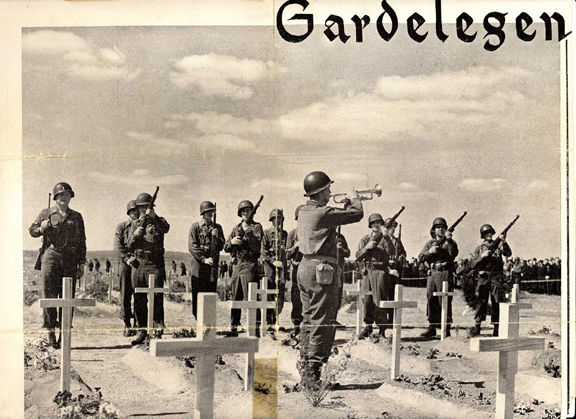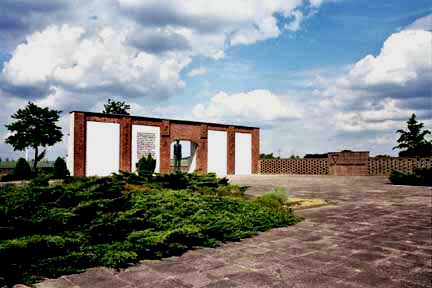Gardelegen Massacre, 13 April 1945Military cemetery for the victims The photo above is on the cover of the pamphlet prepared by the 102nd Division and given to each of the soldiers who were there.  General Frank A. Keating, the Commander of the 102nd Division of the US Ninth Army, initially ordered that the bodies of the Gardelegen massacre victims should be buried on April 18th in mass graves, just like the victims who were being buried that same day at Bergen-Belsen, a horror camp that had been turned over to the British on April 15, 1945. The men of Gardelegen were ordered to dig seven long trenches to bury the bodies in the area just south of the barn, as shown in the photograph above. After two days, General Keating received an order from General Dwight D. Eisenhower, Supreme Allied Commander, that the Gardelegen victims were to be buried in a military cemetery with full honors, including a 21-gun salute. This was the first time in World War II that dead concentration camp prisoners were buried in a military cemetery. The photograph above shows the digging of the mass graves, which had to be opened up again two days later. The construction of the military cemetery by the Gardelegen citizens began on April 21, 1945, as shown in the photograph below. The reason that the victims of the Gardelegen massacre were given the honor of a military burial may have been because some of them were Soviet Prisoners of War and the Soviet troops would soon be arriving in Gardelegen to take charge because Gardelegen was going to be in occupation zone of the Soviet Union by prior agreement.  The following quote is from an article written by Karel Margry, which was published in Issue 111 of After the Battle magazine in 2001: The American guards were in a foul mood and used rifle butts to drive unwilling workers into the barn. The Germans had to move the dead with bare hands and no one was allowed to wear gloves. At one point, there was even a fake execution, a large group of Germans being put against the barn wall and a firing squad taking aim. Freed camp inmates were brought to the site to point out men they knew to be implicated. The Americans had trouble preventing the former prisoners from lynching those Nazis that were recognized. Freed Polish forced labourers and Russian prisoners of war beat and kicked the Germans and called out to the Americans to kill them all. T-4 Philip A. Feick was one of the American soldiers who was brought to Gardelegen on April 18th, on the orders of General Dwight D. Eisenhower, to witness the aftermath of the Gardelegen massacre. He brought home photos that he took and told his family what he had seen. His son, William Feick, wrote the following, regarding the scene at the barn, in an e-mail letter to me: The townspeople were ordered to remove the bodies from the barn. One man refused this order and replied "No." The soldier next to Dad repeated again to pick up the body -- the reply again was "No." Dad recalls vividly as this soldier grabbed the bolt on his rifle, loaded and shot the knee off the townsman. I have not read of this incident in any of the accounts, but feel it very important to show the bitter attitude of the German. No remorse was felt or shown -- just hate. Put yourself there -- that soldier ordered him twice at gunpoint and the reply was No. Emotions had to run very high -- on both sides. Dad said, "I heard the bolt pull back, fired and he blew his knee off." The following quote is from an article in the magazine After the Battle, written by Karel Margry, which was published in 2001: A final resting place was laid out according to the regulations for US military cemeteries about 150 meters south-west of the barn. Lieutenant Colonel William R. Douglas, CO of the 102nd Quartermaster Company, and 1st Lieutenant George A. Carlson of 1st Platoon, 3046th Graves Registration Company, supervised its construction which began on the 21st. The citizens of Gardelegen dug the graves, interred the bodies, erected either a cross or Star of David over each, and surrounded the entire site with a white fence. On April 22, each man assembled in the town square was in addition given a white wooden cross to carry. The exhumation and burial took until the 24th. A total of 574 corpses were recovered from the grave pits and 442 from the barn adding up to a total of 1,016 victims. Of these, only 4 could be identified by name, another 301 merely by their prisoner number. The unidentified totaled 711. Nationality could be established of only 186 bodies: among the dead were 60 Poles, 52 Russians, 27 Frenchmen, 17 Hungarians, eight Belgians, five Germans, five Italians, four Czechs, four Yugoslavs, two Dutchmen, one Mexican and one Spaniard. A number of them were Jews. (After the war, a few more victims were identified from the recorded prisoner numbers.) At the entrance to the cemetery, a big sign was erected with a text in English and German: "Here lie 1,016 Allied prisoners of war who were murdered by their captors. They were buried by the citizens of Gardelegen, who are charged with the responsibility that these graves are forever kept as green as the memory of these unfortunates will be kept in the hearts of freedom-loving men everywhere." The wording on the cemetery sign is misleading since the majority of the victims were technically not Prisoners of War, which means soldiers in uniform in an opposing Army who have been captured in battle in war time. Many of the prisoners who were killed in the barn had been sent to a concentration camp after being captured while fighting as illegal combatants. However, on June 8, 1944, two days after the start of the Allied invasion at Normandy, General Dwight D. Eisenhower unilaterally declared that all illegal combatants were to have the same status as Allied soldiers who were fighting against the German Army. In the war crimes trials after World War II, Eisenhower's declaration was extended to include prisoners in the concentration camps, who were retroactively given the status of Prisoners of War. The photo below shows the sign at the Gardelegen Memorial Site, which identifies the victims as international resistance fighters against Fascism, not as POWs.  Although there were some Soviet Prisoners of War among the dead, most of the victims were insurgents who had continued to fight after their country had surrendered to the enemy, which was a violation of the 1929 Geneva Convention. As such, these resistance fighters were not protected under the rules of the 1929 Geneva Convention with regard to Prisoners of War and they did not observe the rules of the Geneva Convention themselves. After the war, staff members of the concentration camps were charged with a war crime for not treating captured partisans as prisoners of war, but according to the 1929 Geneva Convention, partisans, insurgents, spies and resistance fighters were illegal combatants. A formal military burial ceremony was held on the afternoon of April 25, 1945. General Keating ordered the whole town to attend the ceremony. Col. George P. Lynch, Chief of Staff of the 102nd Division, made a speech in which he told the citizens of Gardelegen: The German people have been told that stories of German atrocities were Allied propaganda. Here, you can see for yourself. Some will say that the Nazis were responsible for this crime. Others will point to the Gestapo. The responsibility rests with neither -- it is the responsibility of the German people....Your so-called Master Race has demonstrated that it is master only of crime, cruelty and sadism. You have lost the respect of the civilized world. ("Master Race" is the American translation of the German term Herrenvolk which literally means aristocratic ethnic group. The British translation is "Race of Lords.") Around the same time, a British Army officer was condemning the citizens of the towns of Bergen and Belsen with similar words on their forced visit to the Bergen-Belsen concentration camp. The plan of the Allies was to make the entire population of Germany feel guilty about not turning against their country. The civilian population of Gardelegen had had a choice; they could have become traitors to their country in giving aid to their enemies in war time by freeing these prisoners who were mainly illegal combatants. Instead, they chose to become "bystanders" by cowering in their homes, hoping that they would be saved by German troops and the leaders of their town. By becoming "bystanders," they "lost the respect of the civilized world." The sign that you see at the cemetery today is a reconstruction, erected in 1990, although the original sign is kept in a museum. The original white fence around the cemetery was no longer there when I visited in May 2002. For years the citizens of Gardelegen faithfully kept up the cemetery. Gardelegen was located in East Germany and, after the war, the men in the graves became the Allies of the East Germans, who were now Communists. The site of the massacre was made into an anti-Fascist Memorial, which was formally dedicated in 1953.  Today, the population of Gardelegen is multi-cultural with many recent immigrants from Africa and Vietnam. When I visited in May 2002, the graves were not being "kept as green as the memory of these unfortunates." The current citizens of Gardelegen have their own problems and from what I observed in May 2002, the town had not yet recovered from the Communist era. During my visit to the town, I got the impression that today's Gardelegen residents couldn't care less about Communist resistance fighters and Russian Prisoners of War who were murdered there over 60 years ago. Prisoners who escapedGerhard Thiele ordered the massacreOld Photos contributed by soldiersOld Photos contributed by Ethel B. StarkKarel Margry's account of the massacreText of Memorial Site PamphletGermans forced to see the barnGermans forced to construct cemeteryPamphlet made by 102nd DivisionHomeThis page was last updated on August 2, 2008 |